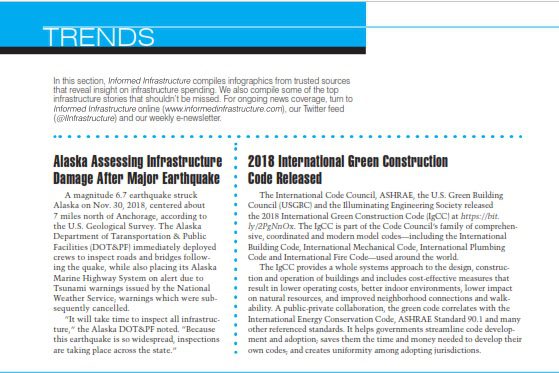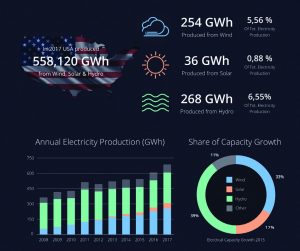November – December 2018 TRENDS

Alaska Assessing Infrastructure Damage After Major Earthquake
A magnitude 6.7 earthquake struck Alaska on Nov. 30, 2018, centered about 7 miles north of Anchorage, according to the U.S. Geological Survey. The Alaska Department of Taransportation & Public Facilities (DOT&PF) immediately deployed crews to inspect roads and bridges following the quake, while also placing its Alaska Marine Highway System on alert due to Tsunami warnings issued by the National Weather Service; warnings which were subsequently cancelled.
“It will take time to inspect all infrastructure,” the Alaska DOT&PF noted. “Because this earthquake is so widespread, inspections are taking place across the state.”
2018 International Green Construction Code Released
The International Code Council, ASHRAE, the U.S. Green Building Council (USGBC) and the Illuminating Engineering Society released the 2018 International Green Construction Code (IgCC) at https://bit.ly/2PgNnOx. The IgCC is part of the Code Council’s family of comprehensive, coordinated and modern model codes—including the International Building Code, International Mechanical Code, International Plumbing Code and International Fire Code—used around the world.
The IgCC provides a whole systems approach to the design, construction and operation of buildings and includes cost-effective measures that result in lower operating costs, better indoor environments, lower impact on natural resources, and improved neighborhood connections and walkability. A public-private collaboration, the green code correlates with the International Energy Conservation Code, ASHRAE Standard 90.1 and many other referenced standards. It helps governments streamline code development and adoption; saves them the time and money needed to develop their own codes; and creates uniformity among adopting jurisdictions.
New Construction Starts in 2019 to Hold Steady
Dodge Data & Analytics released its 2019 Dodge Construction Outlook, which predicts that total U.S. construction starts for 2019 will be $808 billion, staying essentially even with the $807 billion estimated for 2018.
“Over the past three years, the expansion for the U.S. construction industry has shown deceleration in its rate of growth, a pattern that typically takes place as an expansion matures,” stated Robert A. Murray, chief economist for Dodge Data & Analytics. “After advancing 11% to 14% each year from 2012 through 2015, total construction starts climbed 7% in both 2016 and 2017, and a 3% increase is estimated for 2018. There are, of course, mounting headwinds affecting construction, namely rising interest rates and higher material costs, but for now these have been balanced by the stronger growth for the U.S. economy, some easing of bank lending standards, still-healthy market fundamentals for commercial real estate, and greater state financing for school construction and enhanced federal funding for public works.”
According to the report, “an important question going into 2019 is whether deceleration is followed by a period of high-level stability or a period of decline. For 2019, it’s expected that growth for the U.S. economy won’t be quite as strong as what’s taking place in 2018, as the benefits of tax cuts begin to wane.”
New Study Shows Design-Build Continues to Deliver Projects Most Efficiently
New research from a CII/Pankow study shows that America’s design-build projects continue to deliver faster, and with greater reliability in cost and schedule performance, than other delivery methods. According to the report, projects using Design-Build (DB) cost 1.9% less per square foot, on average, when compared to Construction Manager at Risk (CMR) and 0.3% less when compared to Design-Bid-Build (DBB). DB projects also average 2.4% less cost growth than a comparably scoped project using CMR and 3.8% less cost growth than a project using DBB.
In addition, DB was the best-performing project delivery system in terms of schedule growth, delivery speed and construction speed. DB projects see 3.9% less schedule growth than CMR and 1.7% less than DBB. They’re also 13% faster than CMR during the construction phase and 36% faster than DBB. From design through completion, DB projects are delivered 61% faster than CMR and 102% faster than DBB. Read the full report, “Revisiting Project Delivery Performance,” at https://bit.ly/2ALm2yZ.
Renewable Energy in the United States
An infographic focuses on U.S. data for wind, solar and hydro, highlighting renewable energy production as well as the most-recent data for capacity growth.

Lane Construction Corporation Chief Alger Elected ARTBA Chairman
Robert (Bob) E. Alger, P.E., president and chief executive officer of Cheshire, Conn.-based The Lane Construction Corporation, was elected 2018-2019 American Road & Transportation Builders Association (ARTBA) chairman.
Alger’s entire 40-year career in the transportation construction industry has been spent with Lane, where he started as a job engineer in Pennsylvania and rose through the ranks as a project manager, district manager and executive. He was named president and CEO in 2001. His roster of ARTBA volunteer leadership positions includes: senior vice chairman, first vice chairman, Contractors Division president, Contractors Division first vice president, ARTBA Foundation trustee, and Trans2020: “MAP-21 Policy Promotion, Implementation & Funding Enhancement Task Force” co-chair.
TOP Stories
The following are the top stories from the last few months (in terms of traffic) on the Informed Infrastructure website. This also reflects key coverage areas that are regularly refreshed online and via our weekly e-newsletter. Simply search key words on Informed Infrastructure online to find the full story.
Buildings
• Cement Technology Roadmap Shows How the Path to Achieve CO2 Reductions up to 24% by 2050
• A New Brick Could Eliminate Insulation
• Ponce City Market: The Rise, Fall, and Rebirth of Atlanta’s Largest Building
• Video: Vintage Empire State Building Footage Highlights Importance of Construction Safety
Transportation
• U.S. DOT Begins a New Era of Public Transit Safety
• PennDOT Issues Guidance for Increased Safety Oversight of Highly Automated Vehicles
• CDOT and Panasonic Take First Steps to Turn I-70 into Connected Roadway
• The Liberty Bridge Series: Connecting Communities in Puerto Rico
• Video: Michigan DOT Oversees Railroad Crossing Replacement Project
Water
• Video: Kaneohe-Kailua Sewer Tunnel and TIPS Project Overview
• Study Examines Urban Implications of Temporal Rainfall Resolution
• Stantec Awarded Comprehensive Water Treatment Replacement Project
• €12m HYDROUSA Project Aims to Douse Mediterranean Drought
Tools and Technology
• Mobile App Provides Safety Net for Lone Workers
• Video: Large-Scale 3D Printing by a Team of Mobile Robots
• Predict: Greenbyte Energy Cloud’s New Feature Identifies Wind Component Failures Before They Occur
• Newforma Announces New Project Analytics Platform, Based on Microsoft Power BI
• Bentley’s SACS Provides Advanced Analysis and Workflow Enhancements for Offshore Structures


